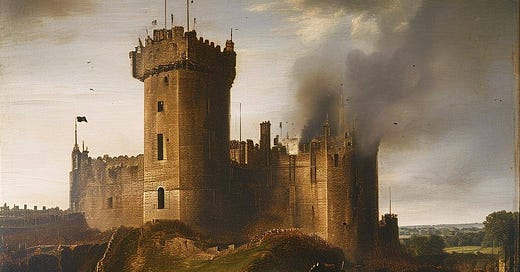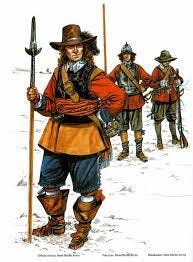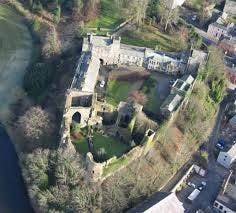How Civil War brought death and destruction to Cumbria’s streets
In August 1648, Charles I’s Cavaliers were bloodily ejected from Cumbrian town by Cromwell’s hymn-singing New Model Army in the last battle of the nine-year conflict
It was the bloodiest time in the town's 1,000-year history. Cockermouth was shattered, abused and impoverished by the nine-year nightmare of the English Civil Wars.
The ordeal reached the endgame in early August 1648. Five hundred ill-disciplined members of Charles Is cavalry swept down the old Roman road from Carlisle.
They besieged the daunting fortress of Cockermouth Castle high on its mound above the confluence of the Cocker and Derwent rivers, aiming to starve out and kill its well-armed garrison of 200 defenders loyal to Oliver Cromwell’s Roundhead party.
The Royalists rained mortar fire and cannon balls onto the castle from a half-moon battery dug into the side of a hill a quarter of a mile away. The king’s men placed their artillery at the corner of Lamplugh Road and Fitz Road and protected it by digging an eight or nine foot deep trench all around.
The Pepperpot House (above) stands on the site today. They fired more ordnance at the castle from a second site at Wood Hall north of the town. As the siege tightened, Royalist soldiers, mainly impoverished second sons of noble fathers, became desperate. Unpaid for months, they robbed the local civilians, held aldermen hostage and forced them to hand over money.
Their commander was the gaunt, austere, womanising Yorkshire aristocrat Sir Marmaduke Langdale. He did little to restrain his marauding troops, whom he cynically called a "rabble of gentility," from raping the women and pillaging the farms in the surrounding countryside.
The military standoff, suffused by smoke, punctuated by thumping mortar shells and strewn with the crack of musket fire was only lifted after a month of street fighting on 29 September 1648.
Cockermouth was eventually liberated by a band of clean-shaven, highly disciplined Parliamentary troops from Cromwell's New Model Army (above). Cromwell personally sent these ideologically driven soldiers, who prayed and read scripture between bouts of killing, direct from the battlefield at Preston 100 miles south.
Cromwell had just led his 8,500-strong Parliamentary force to victory over a Scots-led Royalist army more than twice its size with tactical brilliance. Once Preston had been dealt with, Cromwell selected his the battle-hardened ally, the Lancashire-born Colonel Ralph de Ashton, to rescue Cockermouth Castle from the Royalists.
Cromwell saw that relieving the siege of the castle that guards the route south from Carlisle was essential to end Charles's hopes of getting vital reinforcements from Scotland. The costly struggle over Cockermouth turned out to be the last substantial military action of the entire Civil Wars. Dead bodies appeared in familiar places. It was a horrible and brutal engagement.
Cumberland's descent into the English Civil Wars - which killed a larger proportion of the English population than World War One - left emotional and political scars we still feel today. The conflict was over whether Britain is ruled by an autocrat, Charles I, convinced he was chosen by God to make all the decisions or by the will of the people through Parliament.
The corn and woollen mill town of Cockermouth had enjoyed a century of prosperity and largely remained loyal to the monarchical system that the inhabitants felt had delivered the good life.
But the country as a whole was more divided; especially after Charles I tried to deepen his power by forcing everyone to worship God the same way. The king’s fatal move came when he tried to impose a new Book of Prayer on the puritanical Church of Scotland.
His aim was to bring its practices into line with those of the Church of England that were closer to Catholic doctrine. It was a recklessly arrogant move. It is difficult to convey just how fully religion permeated every aspect of people's lives in the 17th Century. (This is one of the things the Civil Wars changed.)
The hierarchy of priests and bishops with the king at the top of the Church of England was a powerful mechanism for projecting the King's influence into every English town and village. Unsurprisingly, the clergy in Scotland, where the Kirk traditionally enjoyed complete spiritual independence from the State, revolted at his attempt to take over north of the border in the same way. They declared their refusal to comply in a document known as the "National Remonstrance."
Charles, outraged by the challenge to his authority, declared war. On January 29, 1638 he ordered the overwhelmingly Royalist-supporting rural nobility and gentry of Cumberland to arm themselves and defend the north from Scottish invasion. The next year, Charles raised the stakes by sending a 500-strong Royalist garrison to seize Carlisle and its formidable castle.
The citizens rallied to the King. They got out their drums and muskets, collected munitions and began to drill. Yet for a while the main tide of battle remained in the south. This was lucky for the king because the Cumberland Cavaliers were riven by internal squabbles and they found themselves wrong-footed by powerful local political opponents, one in particular.
Algernon Percy, the Protestant 10th Earl of Northumberland, Charles' former Lord High Admiral (head of the Royal Navy) defected to Parliament. Algernon owned Cockermouth Castle, the town and many of the surrounding estates. Algernon had loyally served the royal regime for years. But he hated the Stuarts for jailing his father Henry, the so-called "Wizard Earl," in the Tower of London for 18 years on suspicion of complicity in the Catholic Gunpowder Plot that attempted to assassinate James I, Charles's father.
So Algernon installed a garrison of troops in Cockermouth Castle (above), making the town a stubborn bastion of armed Puritan resistance in a sea of Cumberland Catholicism. On paper, the King had a lot of local support. Some 4,774 Cumberland and Westmorland gentry had loyally signed up to a "Humble Petition and Declaration" to Charles I in July 1642 declaring themselves "ready, according to our power, with our lives and fortunes, to defend Your Majesty's Person."
But these sycophantic promises were belied by their actions. Privately, local Cavalier big-wigs believed the prime objective in any conflict must be to defend their own estates from both sides, not fight Wars for the monarch outside the Lake Counties. But they also intrigued against each other.
For example, Sir Henry Fletcher of Hutton-In-the-Forest, who raised and paid for his own military unit, the Cumberland Trained Band Regiment of Foot, objected to the commander-in-chief of the Royalist Cumberland and Westmorland forces, Sir Philip Musgrave, giving orders to his men which he claimed "confused" them.
Then Musgrave feuded with wealthy Cavalier landowner Sir John Lowther who resisted Musgrave's attempts to muster any troops at all - fearing this would attract unwanted attention from Parliamentary forces massing on the other side of the Pennines. Historian Sir Colin Philips said this lassitude led directly to the Cavalier defeat in the siege of Cockermouth.
In turn, Lowther complained to the northern commander-in-chief, William Cavendish, the Earl of Newcastle, accusing Musgrave of blackening his name. "I am persecuted because I am envied for my power," he wailed. Worse, much of the military equipment the northern Royalists possessed was useless clutter, such as outdated Elizabethan swords, helmets and other leftovers. An investigation a few years before found the two counties could raise only 450 foot soldiers and eighty horsemen between them, half what was judged necessary for sound defence.
There was only one resident gunsmith in the county, supplies of weapon-making tools were inadequate and muskets could not be made for under twenty-three shillings apiece, a prohibitive £3,000 each in today's money. Cockermouth mustered only eighteen horsemen, two without weapons. Rev Edmund Mauleverer of Crosby Garrett, wrote to Musgrave: "I feel me you will find many of the gentry false hearted" noting the "coolness" of Lowther towards any sort of participation in the Civil War. Musgrave agreed: "The gentry seek their owne ends to fearing of themselves."
Lowther confirmed this, confiding to a Lancashire Parliamentarian that "anie levying of armes here and training was only to defend ourselves from the papists and not to offend them." In fact there was a chance the war would be lost before it really took hold in Cumberland. In April 1646 Cromwell forced the King to flee from the siege of his Oxford headquarters.
Charles tried to surrender to the Scots, but they handed him over to the Roundheads anyway. The king escaped the next year from lax house arrest at Hampton Court and did a deal with the Scottish Presbyterian "Engager" faction. With this support, Charles started the Second Civil War. This made Cromwell furious, and he began to contemplate executing “this man of blood”.
In response to the renewed threat from Scotland, the Roundheads reinforced the north. The Roundheads' commander-in-chief Lord Thomas Fairfax (a man increasingly eclipsed by Cromwell's victories) personally selected a brilliant, handsome and confident 29-year-old lawyer-politician, Major-General John Lambert, to command Parliament's northern forces.
Taking over a headquarters in Penrith, Lambert immediately impressed the top brass by suppressing a mutiny and imposing strict discipline. Cockermouth Castle was put under the tough-minded Roundhead Lieutenant William Bird with 200 well-trained men. Lambert's appointment was timely.
Just a few weeks earlier, the Royalists under Sir Philip Musgrave had captured Carlisle for the King with a force of 3,000 foot soldiers and a few hundred horse. Musgrave’s mission was to secure the road into England so that the Duke of Hamilton's army of "Engagers" could cross the border and assist uprisings against Parliament across England. Although Hamilton had wheedled his way into becoming Charles's chief adviser on Scottish affairs, he was widely regarded as unfit for military command.
His inadequacy was rapidly exposed when Lambert's much smaller force of 4,000 horsemen repeatedly outfoxed Musgrave during skirmishes, buying time for Cromwell to roll up the Royalists further south. Another weakness was that the two Royalist armies refused to work together due to a religious dispute.
The Engager army of 6,000 foot soldiers and 3,000 horsemen that eventually marched into Cumberland was too small to be effective and very poorly equipped. The cold and wet summer had encouraged large numbers of Scots to desert en route to England. Hamilton was forced to waste another month waiting for reinforcements, including 3,000 Scottish veterans recalled from Ulster under the command of the bold, powerful and fearless Major-General George Monro.
But Monro quarrelled with Hamilton's second-in-command James Livingston, Earl of Callendar. Monro was highly experienced but he easily imagined himself slighted and was difficult to work with. Livingston saw no reason why Monro should have a separate command. So Monro’s veterans ended up being left behind as a reserve and, once made idle, the Engagers quickly became notorious for violent plundering and lawlessness.
However, the rest of the Royalist forces finally headed south, thinking they had Cumberland at their mercy. They couldn’t have been more wrong.
This is an extract from a new book called Huge & Mighty Forms. There are already five books in the series of Hidden Cumbrian Histories. You can buy them at The New Bookshop, Main Street, Cockermouth, Bookends in Keswick and Carlisle, along with Sam Read in Grasmere.
Buy online here: www.fletcherchristianbooks.com
TO READ THE WHOLE ARTICLE AND MORE, SIGN UP TO A PAID SUBSCRIPTION
Keep reading with a 7-day free trial
Subscribe to Hidden Cumbrian Histories to keep reading this post and get 7 days of free access to the full post archives.







